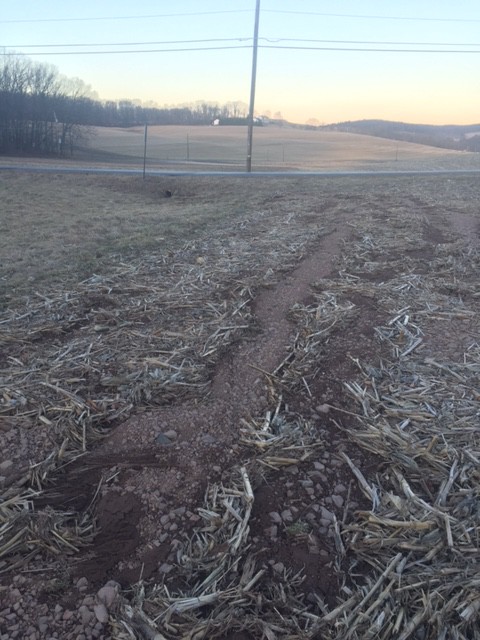By Sjoerd Duiker, Extension Soil Mangement Specialist
Keen observers have noted signs of rill erosion in crop fields. Do we still need conservation practices like grassed waterways and strip cropping to control these?
Reports have been coming in of rill erosion in crop fields. In some cases these rills are transformed into gullies. These fields may be in previously tilled or no-till fields. Rills are the result of concentrated flow cutting into the soil and carrying soil away with runoff. If nothing is done to heal them rills degrade into gullies.
The difference between rills and gullies is that rills can still be crossed easily with farm equipment, but gullies cannot. Rills can easily become gullies in no-till field because the rills are not filled in and in the next runoff event the runoff cuts in a bit more. However, tillage doesn’t solve the problem of concentrated flow runoff, but just covers up its effects – rills will form again next year if concentrated flow occurs.
Here are some tips to avoid rill erosion:
-
Rill erosion can only happen if there is surface runoff. So first of all, we need to use practices in the field that help maximize infiltration. This includes permanent no-tillage, vigorously growing multi-species cover crops, deep-rooted bio-drilling crops, close-growing crops, planting on the contour, heavy mulch cover, perennial grass and forage crops, manure and compost, and avoiding compaction to name just a few.
-
However, even if farmers use all these practices, water may still run off occasionally. During the spring, summer and fall, rainfall events may be so intense that they exceed infiltration capacity on a very healthy soil. Climatologists tell us that these heavy rainstorm events will become more common in our state. So we have to be ready for “the Big One” at all times by armoring the soil with crop residue and living cover and, below ground, live root systems to hold the soil in place.

-
Strip cropping still makes sense, even if no-tillage is used. To alternate strips of annual crops with perennial sod planted on the contour helps stop runoff from creating rills that might form in the annual crop strips. The strips just don’t have to be as narrow as they were in the tillage days because of the improved soil health and increased infiltration in the no-till annual crop strips.
-
Runoff can also form when the subsoil is frozen but the topsoil is already thawed – the water will just not infiltrate when the pores are all full with ice! Additionally, we have soils that have natural impervious layers, such as fragipans. Water ponds on top of these layers leading to a seasonally high water table. Once the top of the water table reaches the soil surface, water will run off, no matter how healthy your soil is. Where this water commonly collects in the landscape to form concentrated runoff, it is really beneficial to have grassed waterways.
The grassed waterways have perennial sod-forming grasses that grow in the summer to create a dense matt and fibrous root mass underground to protect the soil in the winter. My experience is that annual cover crops planted after summer crops often don’t have enough time to develop to provide the same cover as a permanent sod on soils with seasonally high water tables where the cover crops drown out.
-
Finally a word about maintenance of grassed waterways. Grassed waterways need annual maintenance and also to be checked periodically. Annual maintenance includes mowing the waterways about two times a year to keep the vegetation short and promote sod-forming vegetation to tiller for soil protection.
To keep the grass short in the waterway is important to avoid soil carried in runoff to settle out all at the edge of the waterway. This will quickly lead to formation of a ‘bund’ at the waterway edge which will block water entry into the waterway – instead water will start running parallel to the waterway creating a rill (or gully!) on the edge of the waterway. Bund-formation at the edge of the waterway is inevitable but can be slowed down by mowing the vegetation in the waterway from time to time.
After several years, however, some maintenance is needed to remove the bunds – this is an opportunity to enjoy some recreational tillage with a disk to level the edge of the waterway. Don’t forget to reseed the disturbed zone so your grassed waterway does not loose its effectiveness.
It is important to keep good care of our soils, which includes eliminating the scar of rill erosion on our farms.






Post a comment
Report Abusive Comment